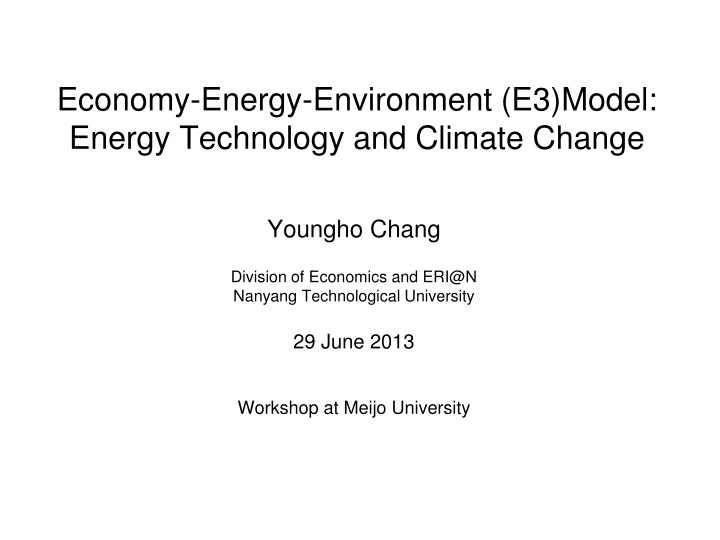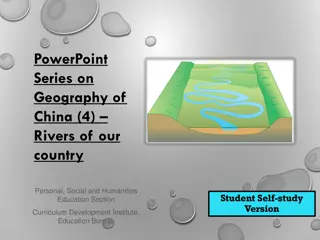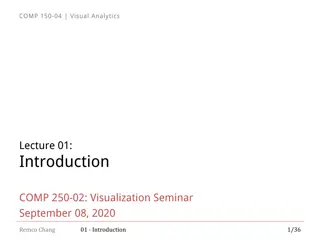
Analyzing the Economy-Energy-Environment (E3) Model and Climate Change Relationship
Explore the intricate connections between the economy, energy, and environment in the context of the E3 model, focusing on energy technology and climate change. Delve into economic approaches, analytical frameworks, and two-sector energy modeling to understand the dynamics of carbon emissions and their impact on the global climate system. Discover the latest developments in climate change, emission trajectories, temperature changes, and global output trajectories, along with the economic implications of energy usage and environmental damage.
Download Presentation

Please find below an Image/Link to download the presentation.
The content on the website is provided AS IS for your information and personal use only. It may not be sold, licensed, or shared on other websites without obtaining consent from the author. If you encounter any issues during the download, it is possible that the publisher has removed the file from their server.
You are allowed to download the files provided on this website for personal or commercial use, subject to the condition that they are used lawfully. All files are the property of their respective owners.
The content on the website is provided AS IS for your information and personal use only. It may not be sold, licensed, or shared on other websites without obtaining consent from the author.
E N D
Presentation Transcript
Economy-Energy-Environment (E3)Model: Energy Technology and Climate Change Youngho Chang Division of Economics and ERI@N Nanyang Technological University 29 June 2013 Workshop at Meijo University
Agenda Introduction Climate Change: Latest Developments The Economics of Climate Change Model Structure Economy Energy Environment Data and Simulation Results Emission Trajectories Temperature Change Global Output Trajectories Concluding Remarks 2
Unequivocal Warming of the Climate System Source: Intergovernmental Panel on Climate Change (2007) 3
Economic Approaches Bottom-up approach Mostly engineering-based Sector-specific energy demand functions No feedback between economic growth and energy demand Not explicitly consider the shadow price of carbon Top-down approach Economic model Adopts a feedback relationship of carbon emissions and their damage upon an economy Lack of details in representing end-uses of energy Insufficient reflection of the impact of more efficient end-use technologies 4
Economy, Energy, and Environment: An Analytical Framework Economy, energy, and environment are interconnected How are they connected? Economy-energy Through the production function Energy is a third input for production along with existing two production factors, capital and labor Energy-environment Through a carbon dynamics Life cycle of carbon When energy is used, it emits carbon dioxide among others, and causes eventual accumulation of carbon in the atmosphere Environment-economy Through possible damage from the accumulated carbon in the atmosphere and/or carbon-abating activity 5
Two-sector Energy Model Maximizes the discounted sum of utility from per capita consumption subject to Capital stock Resource stock Carbon stock The objective function dt e t c u W t c = 0 ) ( )] ( [ max t u(c): the utility from per capita consumption c(t): The per capita consumption : The pure rate of social time preference Population grows exogenously Multiplying population, L(t), By the utility from per capita consumption yields the total utility 6
Production A production technology, F(K, R, L) Exhibits constant returns to scale Linearly homogenous in the three inputs Produces capital goods and consumption goods F = Fi(Ki, Ri, Li), i = end-uses/sectors Ki: the capital stock in each sector Ri: the resource in each sector Li: the labor inputs in each sector Three resources and a backstop technology Oil (P), Coal (A) Natural gas (G) Backstop technology (B). Ri = Pi + Ai + Gi+ Bi, i = end-uses 7
Energy (Resource) An energy-technology framework Represents endogenous substitutions among energy resources Reflects heterogeneous demand between sectors and simultaneous extraction of energy resources across sectors Provides energy profiles for production process Sets into a carbon dynamics Structure Extraction cost (resource production cost) Conversion cost Cost to meet the criteria of each end-use Stock constraint Set availability of the resource Provide transition from one resource to another Scarcity rent: implicit price 8
Resource Cost Function The resource cost, ij, Defined as the sum of extraction cost and conversion costs Ij = ej + zij. and ib = zib When we take into account heterogeneous demand, conversion cost, and extraction cost, we have a resource cost matrix, ij (2x4) i : the sectors (end-uses) The capital goods producing sector The consumption goods producing sector j : the resources Oil Coal Natural gas Solar energy (backstop technology) 9
Environment Carbon Dynamics An aggregate representation of general circulation models (GCMs) An optimal growth-damage framework Captures feedbacks from emission controls through the carbon dynamics to the economy Damages are quantified as some fractions of the global output Structure Emissions Atmospheric concentration of carbons a.k.a. carbon stock Radiative forcings Temperature changes An output scaling factor 10
Workings of Carbon Dynamics When energy resource is used in an economy, it produces Outputs (goods and services) Carbon emissions with other gases A fraction of the emissions increases Atmospheric concentration of GHGs Radiative forcings Equilibrium temperature Eventually imposes a certain level of damage to the economy due to the higher temperature A feedback relationship between climate and economic variables in a macroeconomic structure An economic model Impact of temperature rise on the economy as a whole An energy model A carbon cycle/temperature model Flows of carbon dioxide emissions by economic activities and temperature change 11
Damage from Climate Change Possible damage from climate change is very elusive A major source of climate change Temperature changes due to higher concentrations of greenhouse gases in the atmosphere The impact of climate change Can be express as a function of the change in global mean surface temperature from pre-industrial times, T(t). ( ) ( ) ( 1 t T t Q t D = 2) D(t) : the loss of global output 1 : a parameter representing the scale of damage (0.00144) 2 : an exponent reflecting non-linearity in the damage function (2) 12
Total Costs Function The costs of reducing carbon dioxide emissions ) ( ) ( ) ( t b t Q t TC = b 2 1 TC(t) : the total costs of reducing carbon dioxide emissions : the fractional reduction in greenhouse gas emissions b1 : the scale factor (0.0686) b2 : represent non-linearity of the cost function (2.887) The initial reduction in the carbon dioxide emissions is relatively inexpensive An example If the fractional reduction in greenhouse gas emissions in the year of 1995 is 12 % (0.12), then the total cost of reducing emissions is 0.015 % of the global output 13
Output Scaling Factor A final form of output scaling factor b 1 [ ( ) ] b t 2 = ( ) t 1 + 1 [ ( ) ] T t 2 1 b1 and b2 : parameters of emission reduction cost function 1 and 2 : Parameters of damage function F = iFi(Ki, Ri, Li), i = end-uses/sectors Example If we assume a 3-degree increase in average temperature and 12% reduction in emissions, The value of is 0.987191. The projected global output is 1.28% less than what it would be otherwise 14
Workings of Output Scaling Factor Damage Yes No Yes << 1 < 1 Cost No < 1 1 15
Extraction Costs and Resource Stocks by Grade ($/mmBTU)(Billion mmBTU) Resource Grade I Grade II Grade III Gas 0.92 (6,683.98) 0.60 (11,242.67) 0.65 (225,622.35) Oil 3.47 (4,916.13) 2.37 (121,354.20) Coal 5.08 (82,068.59) 16
Cost of Converting Energy Resources into End Uses ($/Delivered mmBTU) Resources Capital Sector Consumption Sector 13.50 Oil 2.64 Coal 9.10 19.71 Gas 2.13 7.29 Solar 87.91 96.55 17
Simulation Scenarios Simulation periods 1965-2355 (400 years) Simulation scenarios Baseline Technology-related Costs of converting solar energy into electricity Decrease at 5%; 10%; 30%; 50% per decade Policy-related Carbon emissions level is stabilized at 10 billion tons of carbon per year 18
Simulation Results and Interpretations Energy use patterns by sector The faster cost decreases, the earlier the time of switching in resource use Carbon emissions trajectory The faster cost decreases, the lower the peak of carbon emissions Global mean surface temperature change Under the case of cost of using solar energy decreases at 50% per decade, the maximum temperature change could be lower than 2 degree Celsius Global output by technological progress The highest technological progress case (the 50% cost reduction) presents the highest global output trajectory. Impact of different scenarios on discounted consumption The 50% case gives the largest objective value 19
Energy Use Pattern by Sector Baseline Cap S oil oil oil oil oil oil coal coal coal coal coal coal coal coal coal coal coal coal coal coal coal coal coal coal coal coal coal coal coal coal coal coal coal coal coal coal coal coal coal 5% Cap S oil oil oil oil oil oil coal coal coal coal coal coal coal coal coal coal coal coal coal coal coal coal coal coal coal coal coal coal coal coal solar solar solar solar solar solar solar solar solar 10% Cap S oil oil oil oil oil oil coal coal coal coal coal coal coal coal coal coal coal coal coal coal coal solar solar solar solar solar solar solar solar solar solar solar solar solar solar solar solar solar solar 30% Cap S oil oil oil oil oil oil coal coal coal solar solar solar solar solar solar solar solar solar solar solar solar solar solar solar solar solar solar solar solar solar solar solar solar solar solar solar solar solar solar 50% Cap S oil oil oil oil oil oil solar solar solar solar solar solar solar solar solar solar solar solar solar solar solar solar solar solar solar solar solar solar solar solar solar solar solar solar solar solar solar solar solar Emission at 10 Cap S oil oil oil oil oil oil coal coal coal coal coal coal coal coal coal coal coal coal coal coal coal coal coal coal coal coal coal coal coal coal coal coal coal coal coal coal coal coal coal Year 1965 1975 1985 1995 2005 2015 2025 2035 2045 2055 2065 2075 2085 2095 2105 2115 2125 2135 2145 2155 2165 2175 2185 2195 2205 2215 2225 2235 2245 2255 2265 2275 2285 2295 2305 2315 2325 2335 2345 Con S gas gas gas gas/oil oil oil/coal coal coal coal coal coal coal coal coal coal coal coal coal coal coal coal coal coal coal coal coal coal coal coal coal coal coal coal coal coal coal coal coal coal Con S gas gas gas gas/oil oil oil/coal coal coal coal coal coal coal coal coal coal coal coal coal coal coal coal coal coal coal coal coal coal coal coal solar solar solar solar solar solar solar solar solar solar Con S gas gas gas gas/oil oil oil/coal coal coal coal coal coal coal coal coal coal coal solar solar solar solar solar solar solar solar solar solar solar solar solar solar solar solar solar solar solar solar solar solar solar Con S gas gas gas gas/oil oil oil/coal solar solar solar solar solar solar solar solar solar solar solar solar solar solar solar solar solar solar solar solar solar solar solar solar solar solar solar solar solar solar solar solar solar Con S gas gas gas gas/oil oil solar solar solar solar solar solar solar solar solar solar solar solar solar solar solar solar solar solar solar solar solar solar solar solar solar solar solar solar solar solar solar solar solar solar Con S gas gas gas gas/oil oil oil/coal coal coal coal coal coal coal coal coal coal coal coal coal coal coal coal coal coal coal coal coal coal coal coal coal coal coal coal coal coal coal coal coal coal 20
Carbon Emissions Emissions (CO2 equivalent) 45 40 35 30 Billion ton of Carbon Baseline 5% 10% 30% 50% 25 20 15 10 5 0 1965 1985 2005 2025 2045 2065 2085 2105 2125 2145 2165 YEAR 2185 2205 2225 2245 2265 2285 2305 2325 2345 21
Global Mean Surface Temperature Change Global Mean Temperature Change 7 6 5 Baseline 5% 10% 30% 50% Stabilization 4 C Degrees 3 2 1 0 1965 1985 2005 2025 2045 2065 2085 2105 2125 2145 2165 YEAR 2185 2205 2225 2245 2265 2285 2305 2325 2345 22
Global Output Trajectories Global Output 300 250 200 Baseline Trillion US$ 5% 150 10% 30% 50% 100 50 0 YEAR 23
Impacts of Scenarios on Discounted Consumption Impact of Program on Discounted Value of Consumption 1.2 1 0.8 0.6 Percent 0.4 0.2 0 5% 10% 30% 50% E at 10 -0.2 SCENARIOS 24
Concluding Remarks Global negotiation meetings on replacing the Kyoto Protocol in 2013 is on the way and a chance of producing a new global agreement by 2010 is not large Switching to non-carbon emitting fuels would be a solution for mitigating atmospheric accumulation of carbon However, costs needed for realizing such technologies are not verified Policies like stabilizing carbon emission at a certain level are not effective in mitigating temperature rise and costly. The difference between a climate-change and a no- climate-change scenario would be thinner than the pencil needed to draw the curves. Thomas Schelling (1983) 25
Thank you for your attention! Should you have any questions or comments, please contact me at isyhchang@ntu.edu.sg 26




















